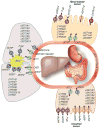Effects of chronic kidney disease and uremia on hepatic drug metabolism and transport
- PMID: 24132209
- PMCID: PMC4276411
- DOI: 10.1038/ki.2013.399
Effects of chronic kidney disease and uremia on hepatic drug metabolism and transport
Abstract
The pharmacokinetics of non-renally cleared drugs in patients with chronic kidney disease is often unpredictable. Some of this variability may be due to alterations in the expression and activity of extra renal drug-metabolizing enzymes and transporters, primarily localized in the liver and intestine. Studies conducted in rodent models of renal failure have shown decreased mRNA and protein expression of many members of the cytochrome P450 enzyme (CYP) gene family and the ATP-binding cassette (ABC) and solute carrier (SLC) gene families of drug transporters. Uremic toxins interfere with transcriptional activation, cause downregulation of gene expression mediated by proinflammatory cytokines, and directly inhibit the activity of the cytochrome P450s and drug transporters. While much has been learned about the effects of kidney disease on non-renal drug disposition, important questions remain regarding the mechanisms of these effects, as well as the interplay between drug-metabolizing enzymes and drug transporters in the uremic milieu. In this review, we have highlighted the existing gaps in our knowledge and understanding of the impact of chronic kidney disease on non-renal drug clearance, and identified areas of opportunity for future research.
Conflict of interest statement
All authors report no competing interests.
Figures
References
-
- Coresh J, Selvin E, Stevens LA, et al. Prevalence of chronic kidney disease in the United States. JAMA : the journal of the American Medical Association. 2007;298:2038–2047. - PubMed
-
- MEDPAC. A Data Book: Healthcare spending and the Medicare program. 2009 Jun
-
- Manley HJ, Cannella CA. Nondialysis (home) medication utilization and cost in diabetic and nondiabetic hemodialysis patients. Nephrology news & issues. 2005;19:27–28. 33–24, 36–28. - PubMed
-
- Manley HJ, Cannella CA, Bailie GR, et al. Medication-related problems in ambulatory hemodialysis patients: a pooled analysis. American journal of kidney diseases : the official journal of the National Kidney Foundation. 2005;46:669–680. - PubMed
-
- Zhang Y, Zhang L, Abraham S, et al. Assessment of the impact of renal impairment on systemic exposure of new molecular entities: evaluation of recent new drug applications. Clin Pharmacol Ther. 2009;85:305–311. - PubMed
Publication types
MeSH terms
Substances
Grants and funding
LinkOut - more resources
Full Text Sources
Other Literature Sources
Medical



